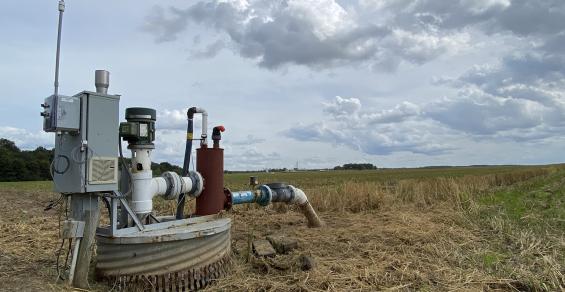Tailwater recovery research shows significant water savings in row rice
Arkansas Agricultural Experiment Station researchers are steadily improving water conservation tactics. They can now grow rice with about half the irrigation water used in levee rice systems.
Chris Henry, associate professor and water management engineer for the experiment station, the research arm of the University of Arkansas System Division of Agriculture, has patented a tailwater recovery system for furrow-irrigated rice, also known as “row rice,” after nearly a decade of research at the Division of Agriculture’s Rice Research and Extension Center near Stuttgart.
Row rice irrigation is challenging because it requires more frequent cycles than other row crops and timing is more critical because rice has a shallower root system, Henry said.
“We’re trying to make row rice easier to manage. This system does that,” Henry said. “A continuous-flow system returns the water to the top of the field constantly, ensuring water is always available and simplifying irrigation management.”
The efficiency is high because the system captures the tailwater and returns it to the top. The irrigation water doesn’t leave the field like a conventional row rice field.
Cometitive system
Henry’s novel tailwater recovery system makes furrow-irrigated rice competitive in water conservation with a zero-grade flooded field. Growing rice in zero-grade fields is more restrictive because it requires land with no elevation change. Zero-grade fields also present challenges in growing rotation crops.
According to the B.R. Wells Arkansas Rice Research Studies 2020 publication, most of the state’s rice is grown in flooded fields through a method known as Multiple Inlet Rice Irrigation (MIRI) or conventional levee and gate systems. Traditional flooding, still the dominant rice production method, uses an average of 30 acre-inches of irrigation water a season. Henry’s novel tailwater recovery system can produce as much rice with less than 19 acre-inches of irrigation. An acre-inch is equivalent to one inch of water depth over an acre of land or 27,154 gallons per acre.
Throughout his research since 2013, Henry said he has not used over 19 acre-inches of irrigation water with the tailwater recovery system. He has used as little as 12 acre-inches.
The goal of furrow-irrigated rice is to achieve increased profit margins by reducing input costs, according to the Arkansas Furrow-Irrigated Rice Handbook (https://bit.ly/ArkansasFIRHandbook). But it can also use less water if coupled with tailwater recovery. Furrow-irrigated rice also offers no-till options, along with the ability to plant cover crops and build soil health or rotate crops to soybeans, corn or other food crops.
Furrow-irrigated rice has gained momentum over the past seven years. In 2015, less than 1% of Arkansas rice land used furrow irrigation. By 2019, it had grown to 10.5% and in 2020 it was about 17%, according to Jarrod Hardke, rice extension agronomist with the Division of Agriculture.
Henry said water conservation is an increasingly important issue as fresh groundwater becomes less abundant.
Groundwater report
The 2020 Arkansas Groundwater Protection and Management Report (https://bit.ly/2020ArkansasGroundwaterReport), a publication from the Arkansas Department of Agriculture Natural Resources Division, stated groundwater use rates in the state’s rice production areas were “unsustainable.”
Based on 2015 water use data, less than half of the amount of water drawn from the Mississippi River Valley Alluvial Aquifer – 44.2% – is sustainable. Users of the aquifer pulled about 7.6 billion gallons per day out in 2015. Likewise, only about half – 55% – of the Sparta/Memphis aquifer withdrawal rate of 160 million gallons per day is sustainable, the report adds.
According to the U.S. Department of Agriculture National Agricultural Statistics Service, Arkansas typically produces nearly half of the rice in the nation. The 2021 Arkansas Agriculture Profile (bit.ly/2021 ArkAgProfile) records 1.4 million acres of rice harvested in 2020 with a value of $1.297 billion.
Average seasonal irrigation demands range widely for different soil types and field designs, Hardke said. So, at 27,154 gallons per acre-inch, a farmer would need 814,620 gallons of water per acre to sufficiently water rice grown on a silt loam soil to achieve the average required irrigation of 30 acre-inches in a flooded field with levees, Hardke said.
A zero-grade flooded field — one with no elevation difference to require an infield levee — averages about 18-acre inches of irrigation water, he said.
“We are doing as good or better than a zero-grade flooded field,” Henry said. “It makes row rice field management like zero-grade but offers you the benefit of rows that can be used in subsequent seasons. You can potentially plant several weeks sooner than a conventional levee rice field because the tillage prep work to convert the beds to flooded levees is not necessary.”
The system can reduce a farmer’s need for capital equipment, tractors, tillage equipment, and the labor to prepare fields, Henry added.
“It can also allow more options for ground operations of fertilizer and pesticide applications providing the farmer with more options for rice management,” Henry said.
The novel tailwater system has the most potential in rice but is also helpful in improving irrigation efficiency of our other crops such as soybeans, corn and cotton because it can recover tailwater for use during an irrigation event, Henry added.
Benefits of continual flow
In addition to less irrigation water, Henry’s patented continuous-flow system in row rice provides more consistent ground saturation, which may produce less nitrous oxide than other irrigation methods, Henry said. The saturation can also reduce pigweed pressure, he added.
Research by crop, soil, and environmental sciences professor Kristofor Brye’s graduate student Jordan M. Slayden for the experiment station in 2018 and 2019 showed that a no-till, furrow-irrigated rice field produced less nitrous oxide than a conventional-till field. Geoderma Regional published the study’s results in the March 2022 issue (https://bit.ly/ArkansasN2OinRice). Slayden’s report noted that more consistent rice field saturation could further decrease nitrous oxide.
Before Henry’s technical development, furrow-irrigated rice growers were warned of a possible 8% yield reduction in row rice production depending on field conditions and management capabilities. Henry said some recent experience and results suggest that his system may be closing that yield gap typically experienced by farmers and noted in published studies.
Instead of a large water reservoir, or “pit,” common with conventional furrow-irrigation methods, the tailwater recovery uses a low-energy, high-flow-low-head, variable-speed pump at the lowest elevation of the field to return the water to the top of the field.
Henry’s “pitless” tailwater recovery system recycles about 90% of the water in the system. The method also provides options for “fertigation,” or fertilizing with irrigation water. Henry continues to test slow-release nitrogen application methods in row rice, which may allow one application of nitrogen at the beginning of the season with potash and phosphate. Henry said it could be a time-saver for the farmer at no additional cost.
Savings contest
Stephen Hoskyn, a rice farmer near Stuttgart, used the tailwater recovery system to win the 2021 Most Crop Per Drop contest. It was the first time row rice won the Division of Agriculture contest created in 2018. Hoskyn produced an average of 9.77 bushels of rice per acre-inch of total water. For the competition, water-use efficiency is calculated by dividing yield by the total water — rain plus irrigation — received by a field.
Hoskyn harvested nearly 240 bushels per acre corrected to 12% moisture by applying 13.47 acre-inches of irrigation water and 29.56 acre-inches of total water.
“In a flooded field, you’re lucky to get 200 bushels per acre, and the state average is about 170 bushels,” Henry said.
Because it is still a new method in row rice, more work is needed to fully understand the tailwater recovery system, Hardke said. In addition to water use, research remains on fertilizer application and weed and pest control using the system.
Henry’s research includes finding ways to reduce bed erosion with the new system. One way is to use low-lying plastic hose extensions with plastic mulch at the poly pipe.
The continuous-flow system may not fit every farmer’s situation, Henry said. It is not suited to fields with an elevation difference over 10 feet.
Henry has worked to improve the method at the Rice Research and Extension Center in Stuttgart since he arrived in 2013. So far, he knows of only about five rice farmers in Arkansas using the method, and he is working on licensing the patents for the system to third-party businesses to build them.
The U.S. Department of Energy has supported research on the tailwater recovery system, along with the Arkansas Rice Research and Promotion Board and the Arkansas Natural Resources Conservation Service, which is part of the USDA.




